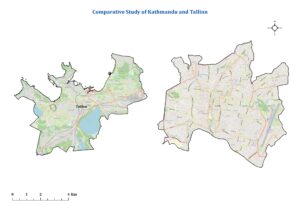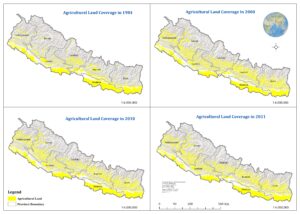The picturesque Kathmandu valley in Nepal boasts a stunning blend of landscapes and cultures. Recently, a closer look at the drainage systems within the region has revealed a fascinating tapestry of challenges and successes. In focus are the districts of Kathmandu, Lalitpur, and Bhaktapur. This article aims to break down the complexities of water management and infrastructure development, providing a comprehensive understanding of the current state and the way forward for sustainable growth. Our journey commences in the bustling district of Kathmandu, where the diversity of palikas unfolds. Shankharapur emerges as a microcosm of this diversity, showcasing a dynamic mix of well and moderately well to well drainage systems. Meanwhile, the palikas of Budhanilakantha and Tarakeshwor paint a spectrum of efficiency, ranging from well to moderately well to rapid. Nagarjun, characterized as moderately well, strikes a balance in its drainage infrastructure. Venturing into Lalitpur, neighboring Kathmandu, the narrative unfolds in areas like Godawari and Mahalaxmi. Godawari’s drainage system, ranging from moderately well to well, suggests stable conditions. However, the term ‘variable; subject to severe river flooding’ rings an alarm, calling for strategic planning to address vulnerabilities. Bhaktapur, the third district in our exploration, features palikas like Changunarayan, Suryabinayak, and Bhaktapur itself. Changunarayan’s moderately well system indicates a moderate level of efficiency, while Suryabinayak echoes a similar sentiment.
Well-Functioning Drainage Systems:
Certain areas within the province, such as Budhanilakantha, Gokarneshwor, and Kageshwori Manahora, serve as exemplars with their well-functioning drainage systems. The term ‘well’ denotes an infrastructure that not only efficiently manages water but also mitigates the risk of water-related issues. These areas stand as proof of the positive impact of robust water management on both residents and local authorities.
Moderately Well to Well Systems:
Palikas like Tarakeshwor, Shankharapur, and Chandragiri depict a landscape of drainage systems categorized as ‘moderately well to well.’ This suggests a stable performance with room for improvement. These areas may benefit from strategic investments and proactive maintenance to elevate the efficiency of their drainage systems, particularly during adverse weather conditions.
Rapid and Poor Drainage Systems:
In contrast, palikas such as Tarakeshwor, Nagarjun, and Kirtipur face challenges with drainage systems labeled as ‘rapid’ or ‘poor.’ This indicates potential issues in effectively managing water flow, resulting in problems like flooding or inadequate drainage during heavy rainfall. Urgent attention and substantial investment in infrastructure are paramount to prevent and mitigate the impact of water-related challenges on the community.
Variable and Subject to Flooding:
Vulnerabilities surface in areas designated as ‘variable’ and ‘subject to severe river flooding,’ notably in Lalitpur’s Godawari and Mahalaxmi, as well as Kathmandu’s Chandragiri. This designation underscores the need for comprehensive planning and targeted infrastructure development to address the potential impact of flooding on communities. The unpredictability of these areas calls for proactive measures to safeguard residents and their livelihoods.
Imperfect and Severe River Flooding:
The descriptors ‘imperfect’ and ‘subject to severe river flooding’ raise red flags in areas like Dakshinkali, Mahalaxmi, and Godawari in Lalitpur. These regions are at heightened risk of severe water-related issues, demanding immediate intervention. Urgent measures are required to enhance the resilience of drainage infrastructure, ensuring the safety and well-being of the communities residing in these vulnerable zones.
The Human Dimension:
Beyond the technicalities of drainage systems, it’s imperative to recognize the human dimension of this narrative. The efficiency of water management directly impacts the lives of the residents in these regions. For areas with well-functioning drainage systems, the benefits are evident – reduced risk of flooding, better sanitation, and an overall enhanced quality of life. On the flip side, regions with challenges in their drainage systems face daily struggles, with residents contending with the aftermath of inadequate infrastructure.
Socio-Economic Implications:
The state of drainage systems has profound socio-economic implications. Well-managed water systems contribute to a conducive environment for economic activities, safeguarding agricultural lands, and promoting local businesses. On the other hand, regions facing drainage challenges are likely to experience disruptions in livelihoods, increased vulnerability to natural disasters, and a potential decline in economic productivity.
Environmental Considerations:
The impact of drainage systems extends beyond human communities to the environment itself. Effective water management mitigates the risk of soil erosion, protects ecosystems, and ensures the sustainability of water resources. Conversely, poorly managed drainage systems can lead to environmental degradation, affecting biodiversity, water quality, and overall ecosystem health.
In conclusion, this detailed exploration unveils the intricacies of Bagmati province’s drainage systems. It is not just an inventory of infrastructure but a call to action. The diversity across districts and palikas emphasizes the need for a nuanced, community-driven approach to water management. It calls for collaboration between local communities and authorities to bolster existing infrastructure, ensuring a resilient and water-secure future for Nepal. The collective efforts of residents, authorities, and policymakers will undoubtedly shape the province’s destiny, steering it towards a harmonious coexistence with its waterways and laying the foundation for a sustainable legacy. As Bagmati continues its journey, navigating the waters with resilience and foresight will be paramount in ensuring a flourishing future for generations to come.




